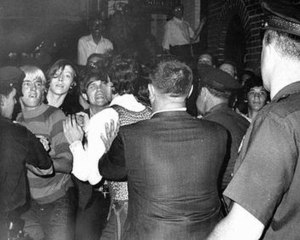| Stonewall riots | |||
|---|---|---|---|
| Part of events leading to gay liberation | |||
 The only known photograph taken during the first night of the riots, by freelance photographer Joseph Ambrosini, shows gay youth scuffling with police.[1] | |||
| Date | June 28 – July 3, 1969[2] | ||
| Location | 40°44′02″N 74°00′08″W / 40.7338°N 74.0021°W | ||
| Caused by | Police raid on the Stonewall Inn (specifically) General repression of LGBT rights (more broadly) | ||
| Goals | Gay liberation and LGBTQ rights in the United States | ||
| Methods | Rioting, street protests | ||
| Parties | |||
| |||
| Number | |||
| |||
The Stonewall riots, also known as the Stonewall uprising, Stonewall rebellion, Stonewall revolution,[3] or simply Stonewall, were a series of spontaneous demonstrations against a police raid that took place in the early morning hours of June 28, 1969, at the Stonewall Inn, in the Greenwich Village neighborhood of New York City. Although the demonstrations were not the first time American homosexuals fought back against government-sponsored persecution of sexual minorities, the Stonewall riots marked a new beginning for the gay rights movement in the United States and around the world.[note 1]
American gays and lesbians in the 1950s and 1960s faced a legal system more anti-homosexual than those of some Warsaw Pact countries.[note 2] Early homophile groups in the U.S. sought to prove that gay people could be assimilated into society, and they favored non-confrontational education for homosexuals and heterosexuals alike. The last years of the 1960s, however, were very contentious, as many social movements were active, including the African American Civil Rights Movement, the Counterculture of the 1960s, and antiwar demonstrations. These influences, along with the liberal environment of Greenwich Village, served as catalysts for the Stonewall riots.
Very few establishments welcomed openly gay people in the 1950s and 1960s. Those that did were often bars, although bar owners and managers were rarely gay. The Stonewall Inn was owned by the Mafia[4][5] and catered to an assortment of patrons, popular among the poorest and most marginalized people in the gay community: drag queens, representatives of a newly self-aware transgender community, effeminate young men, hustlers, and homeless youth. Police raids on gay bars were routine in the 1960s, but officers quickly lost control of the situation at the Stonewall Inn and attracted a crowd that was incited to riot. Tensions between New York City police and gay residents of Greenwich Village erupted into more protests the next evening and again several nights later. Within weeks, Village residents quickly organized into activist groups to concentrate efforts on establishing places for gays and lesbians to be open about their sexual orientation without fear of being arrested.
Following the Stonewall riots, sexual minorities in New York City faced gender, class, and generational obstacles to becoming a cohesive community. In the weeks and months after, they initiated politically active social organizations and launched publications that spoke openly about rights for gay people. The first anniversary of the riots was marked by peaceful demonstrations in several American cities that have since grown to become pride parades. The Stonewall National Monument was established at the site in 2016. Today, pride events are held annually throughout the world toward the end of June to mark the Stonewall riots.
- ^ Carter 2004, p. 162.
- ^ Grudo, Gideon (June 15, 2019). "The Stonewall Riots: What Really Happened, What Didn't and What Became Myth". The Daily Beast.; "New-York Historical Society commemorates 50th anniversary of Stonewall Uprising with special exhibitions and programs". New-York Historical Society. April 23, 2019.; "Movies Under the Stars: Stonewall Uprising". New York City Department of Parks and Recreation. June 26, 2019. Archived from the original on August 7, 2020. Retrieved July 5, 2019.
- ^ Jenkins, Andrea (2019). "Power to the People: The Stonewall Revolution". QED: A Journal in GLBTQ Worldmaking. 6 (2): 63–68. ISSN 2327-1590.
- ^ Duberman 1993, p. 183.
- ^ Carter 2004, pp. 79–83.
Cite error: There are <ref group=note> tags on this page, but the references will not show without a {{reflist|group=note}} template (see the help page).